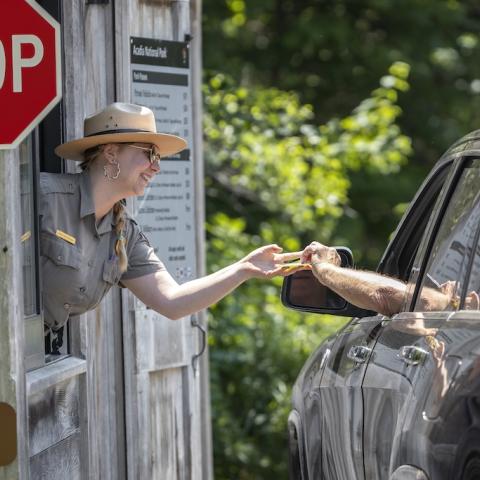
Common loons justify a birding trip to Voyageurs National Park/Kirby Adams
I’ve talked at length about the best parks for birds and the parks where all the birders go. Everglades National Park usually tops that list. Big Bend and Acadia are also extremely popular birding parks. But which of the 59 national parks gets the least birding attention? That’s tough to quantify, but I’ve made an educated guess from perusing eBird data.
It’s not shocking that the Alaska parks don’t get many birders. They don’t get many visitors, period! To keep this race for a non-existent ignominious title fair, I’m going to look only at parks in the contiguous 48 states. Of the five parks that seem to show the least birding activity, I can think of great birding adventures to be had in each.
It’s a bit surprising there aren’t more summer birding reports from this area. There are none for the winter months, of course. The boreal corvids, Clark’s Nutcracker, Gray Jay, and Common Raven, are great birds to see in the northern mountains. One of the nicest things about these birds – at least for the jay and nutcracker – is their relative tameness. A hiker with a bag of trailmix can likely get a nutcracker close enough for a fabulous photo and possibly get the Gray Jay in hand - literally.

Gray jays alone justify a trip to North Cascades National Park/Kirby Adams
Great Basin does get a little more birding activity than the others on this list, but it’s still more under-birded than it deserves to be. The elevation change from the sagebrush plains to the top of Wheeler Peak provides great bird diversity on an afternoon’s drive. As with many under-birded and under-visited parks, it suffers from its remote location. It’s in the middle of nowhere, halfway between two birding super hotspots: the Great Salt Lake and Death Valley. A highlight of Great Basin for me would be seeing some Mountain Chickadees frolicking in a Bristlecone Pine. Tiny, boisterous birds that grace the earth for only a few years gleaning insects from a tree that’s seen four millennia would be a special sight.
Birders are known for going everywhere from Antarctica to the concrete canyons of Manhattan to active war zones in the Middle East in search of birds. Oddly, not many of them make it to Isle Royale. That’s no doubt an artifact of the difficulty in reaching the island and the difficulty in exploring it once there, but some other factors must come into play. One is that it’s not particularly easy to find and get good looks at birds in a boreal forest. The best birding on Isle Royale would be in June during the nesting season. The way to bird the forest at that time of year is to get out to a spot before dawn and wait for the chorus. I would wager 90 percent of the summer birds listed for this park were found by song.
This appears to be the least-birded park on the list. That’s a shame, because Voyageurs is a paddling park and birding by canoe is fabulous fun. Most of the birders who make lists and submit lists and sightings to eBird and online bird groups tend to want to make day trips and have flexibility. That probably keeps them away from multi-day canoe trails. The few lists that do exist for the park read like those from a typical lake in the upper Great Lakes region. Paddling out to a remote part of Voyageurs to hear a Common Loon wailing in the morning fog is high on my bucket list.
Yes, the cave is the highlight of the park, but that doesn’t mean there isn’t great birding topside. Wind Cave is on the edge of the Black Hills region, biogeographically one of the most interesting places on the continent. The Black Hills host numerous species from the northern plains as well the northern and central Rockies. It’s an east-meets-west, south-meets-north, plain-meets-mountain spot that makes for excellent birding and list building. You can see a Lark Sparrow of the northern prairie, and a half-mile away get a Pygmy Nuthatch, typically a denizen of the southern Rockies. I’d go for the cave and stay for the birds – or vice versa.
This list tells me a few things. First, more birders need to visit these parks. Additionally, more casual birders should take a few minutes to record some of their sightings from these parks at eBird. And finally – there’s no bad place to bird and no such thing as a national park that doesn’t offer great birding opportunities!




 Support Essential Coverage of Essential Places
Support Essential Coverage of Essential Places







Add comment